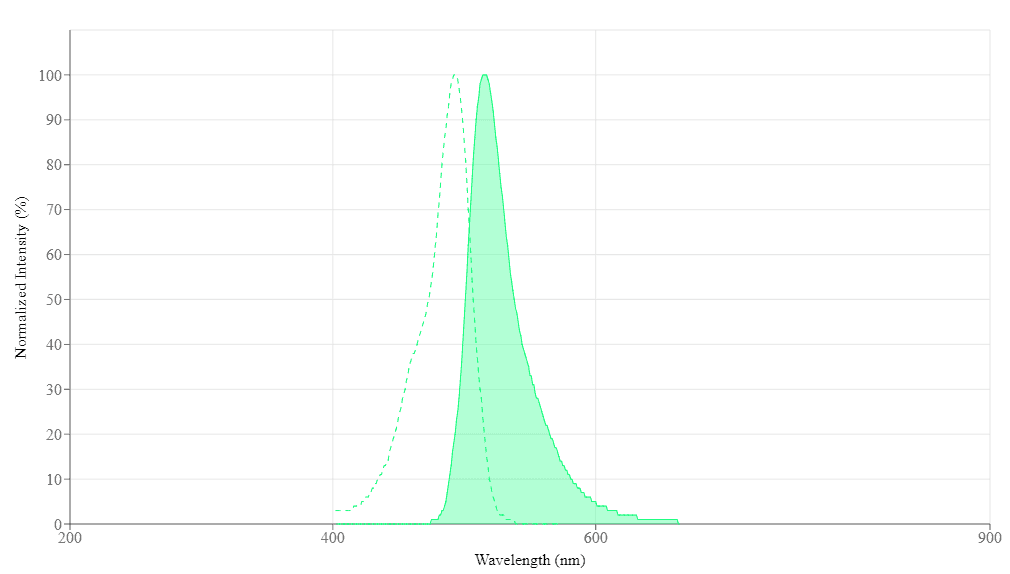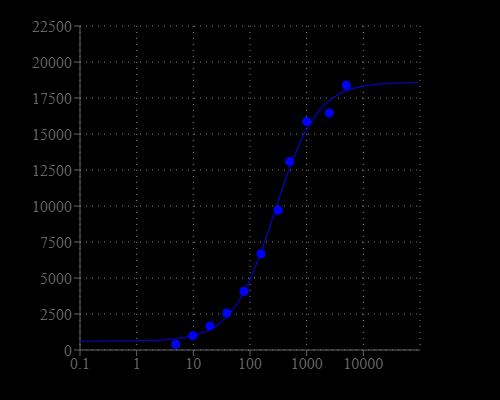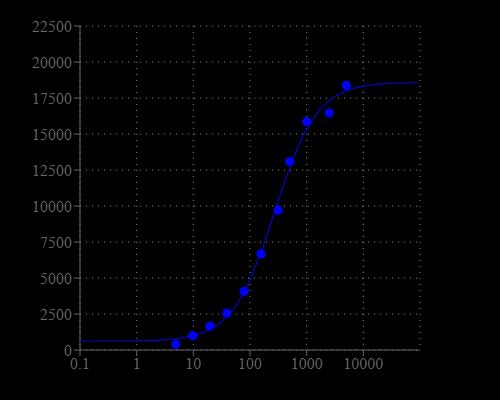Calbryte™-520XL AM
| Price | |
| Catalog Number | |
| Unit Size | |
| Quantity |
| Telephone | 1-800-990-8053 |
| Fax | 1-800-609-2943 |
| sales@aatbio.com | |
| International | See distributors |
| Bulk request | Inquire |
| Custom size | Inquire |
| Shipping | Standard overnight for United States, inquire for international |
| Dissociation constant (Kd, nM) | 300000 |
| Molecular weight | 911.77 |
| Solvent | DMSO |
| Excitation (nm) | 493 |
| Emission (nm) | 515 |
| Quantum yield | 0.751 |
| H-phrase | H303, H313, H333 |
| Hazard symbol | XN |
| Intended use | Research Use Only (RUO) |
| R-phrase | R20, R21, R22 |
| Storage | Freeze (< -15 °C); Minimize light exposure |
| UNSPSC | 12352200 |
| Overview |
Molecular weight 911.77 | Dissociation constant (Kd, nM) 300000 | Excitation (nm) 493 | Emission (nm) 515 | Quantum yield 0.751 |
Platform
Fluorescence microscope
| Excitation | FITC |
| Emission | FITC |
| Recommended plate | Black wall/clear bottom |
Fluorescence microplate reader
| Excitation | 490 |
| Emission | 525 |
| Cutoff | 515 |
| Recommended plate | Black wall/clear bottom |
| Instrument specification(s) | Bottom read mode/Programmable liquid handling |
Example protocol
PREPARATION OF STOCK SOLUTIONS
Unless otherwise noted, all unused stock solutions should be divided into single-use aliquots and stored at -20 °C after preparation. Avoid repeated freeze-thaw cycles
Prepare a 2 to 5 mM stock solution of Calbryte™-520XL AM in anhydrous DMSO.
Note: The Calbryte™-520XL AM stock solution is a clear, colorless solution.
PREPARATION OF WORKING SOLUTION
On the day of the experiment, either dissolve Calbryte™ 520XL AM in DMSO or thaw an aliquot of the indicator stock solution to room temperature.
Prepare a 2 to 20 µM Calbryte™-520XL AM working solution in a buffer of your choice (e.g., Hanks and Hepes buffer) with 0.04% Pluronic® F-127. For most cell lines, Calbryte™ 520XL AM at a final concentration of 4-5 μM is recommended. The exact concentration of indicators required for cell loading must be determined empirically.
Note: The nonionic detergent Pluronic® F-127 is sometimes used to increase the aqueous solubility of Calbryte™ 520XL AM. A variety of Pluronic® F-127 solutions can be purchased from AAT Bioquest.
Note: If your cells contain organic anion-transporters, probenecid (1-2 mM) may be added to the dye working solution (final in well concentration will be 0.5-1 mM) to reduce leakage of the de-esterified indicators. A variety of ReadiUse™ Probenecid products, including water-soluble, sodium salt, and stabilized solutions, can be purchased from AAT Bioquest.
SAMPLE EXPERIMENTAL PROTOCOL
Following is our recommended protocol for loading AM esters into live cells. This protocol only provides a guideline and should be modified according to your specific needs.
- Prepare cells in growth medium overnight.
On the next day, add 1X Calbryte™ 520XL AM working solution to your cell plate.
Note: If your compound(s) interfere with the serum, replace the growth medium with fresh HHBS buffer before dye-loading.
Incubate the dye-loaded plate in a cell incubator at 37 °C for 30 to 60 minutes.
Note: Incubating the dye for longer than 1 hour can improve signal intensities in certain cell lines.
- Replace the dye working solution with HHBS or buffer of your choice (containing an anion transporter inhibitor, such as 1 mM probenecid, if applicable) to remove any excess probes.
- Add the stimulant as desired and simultaneously measure fluorescence using either a fluorescence microscope equipped with a FITC filter set or a fluorescence plate reader containing a programmable liquid handling system such as an FDSS, FLIPR, or FlexStation, at Ex/Em = 490/525 nm cutoff 515 nm.
Calculators
Common stock solution preparation
| 0.1 mg | 0.5 mg | 1 mg | 5 mg | 10 mg | |
| 1 mM | 109.677 µL | 548.384 µL | 1.097 mL | 5.484 mL | 10.968 mL |
| 5 mM | 21.935 µL | 109.677 µL | 219.354 µL | 1.097 mL | 2.194 mL |
| 10 mM | 10.968 µL | 54.838 µL | 109.677 µL | 548.384 µL | 1.097 mL |
Molarity calculator
| Mass (Calculate) | Molecular weight | Volume (Calculate) | Concentration (Calculate) | Moles | ||||
| / | = | x | = |
Spectrum

Spectral properties
| Excitation (nm) | 493 |
| Emission (nm) | 515 |
| Quantum yield | 0.751 |
Product Family
| Name | Excitation (nm) | Emission (nm) | Quantum yield |
| Calbryte™ 520 AM | 493 | 515 | 0.751 |
| Calbryte™ 590 AM | 581 | 593 | - |
| Calbryte™ 630 AM | 607 | 624 | - |
| Calbryte™-520L AM | 493 | 515 | 0.751 |
| Calbryte™-520XL azide | 493 | 515 | 0.751 |
| Calbryte™-520XL-Dextran | 493 | 515 | 0.751 |
Images
Citations
Authors: Wu, Yanjiao and Xu, Xiaoli and Ma, Lunkun and Yi, Qian and Sun, Weichao and Tang, Liling
Journal: The International Journal of Biochemistry & Cell Biology (2017)
Authors: Lu, Jiang and Yao, Xue-qin and Luo, Xin and Wang, Yu and Chung, Sookja Kim and Tang, He-xin and Cheung, Chi Wai and Wang, Xian-yu and Meng, Chen and Li, Qing and others, undefined
Journal: Neural Regeneration Research (2017): 945
Authors: Yang, Gang and Xiao, Zhenghua and Ren, Xiaomei and Long, Haiyan and Ma, Kunlong and Qian, Hong and Guo, Yingqiang
Journal: Scientific Reports (2017): 41781
Authors: Liu, Jia and Du, Qing and Zhu, He and Li, Yu and Liu, Maodong and Yu, Shoushui and Wang, Shilei
Journal: Int J Clin Exp Med (2017): 6861--6868
Authors: Sun, Xia and Lin, Yi and Huang, Qiansheng and Shi, Junpeng and Qiu, Ling and Kang, Mei and Chen, Yajie and Fang, Chao and Ye, Ting and Dong, Sijun
Journal: Journal of cellular and molecular medicine (2015): 581--594
Authors: Zhao, Lantao and Li, Shuhong and Wang, Shilei and Yu, Ning and Liu, Jia
Journal: Biochemical and biophysical research communications (2015): 537--542
Authors: Liang, Nan and Wang, Peng and Wang, Shilei and Li, Shuhong and Li, Yu and Wang, Jinying and Wang, Min
Journal: Journal of Neural Transmission (2014): 593--600
Authors: Li, Qing and Lu, Jiang and Wang, Xianyu and others, undefined
Journal: Neural regeneration research (2014): 2002
Authors: Peng, Xu-Dong and Zhao, Gui-Qiu and Lin, Jing and Jiang, Nan and Xu, Qiang and Zhu, Cheng-Cheng and Qu, Jain-Qiu and Cong, Lin and Li, Hui
Journal: International journal of ophthalmology (2014): 441--447
Authors: Hagiyama, M and Inoue, T and Furuno, T and Iino, T and Itami, S and Nakanishi, M and Asada, H and Hosokawa, Y and Ito, A
Journal: British Journal of Dermatology (2013): 771--778
References
Authors: Bailey S, Macardle PJ.
Journal: J Immunol Methods (2006): 220
Authors: Orlicky J, Sulova Z, Dovinova I, Fiala R, Zahradnikova A, Jr., Breier A.
Journal: Gen Physiol Biophys (2004): 357
Authors: Patel H, Porter RH, Palmer AM, Croucher MJ.
Journal: Br J Pharmacol (2003): 671
Authors: Loughrey CM, MacEachern KE, Cooper J, Smith GL.
Journal: Cell Calcium (2003): 1
Authors: Zhang Z, Kitching P.
Journal: J Virol Methods (2000): 187
Authors: Rockwell PL, Storey BT.
Journal: Mol Reprod Dev (2000): 335
Authors: Cantz T, Nies AT, Brom M, Hofmann AF, Keppler D.
Journal: Am J Physiol Gastrointest Liver Physiol (2000): G522
Authors: Walczysko P, Wagner E, Albrechtova JT.
Journal: Cell Calcium (2000): 23
Authors: Wohlfart B., undefined
Journal: Acta Physiol Scand (2000): 1
Authors: Rockwell PL, Storey BT.
Journal: Mol Reprod Dev (1999): 418

